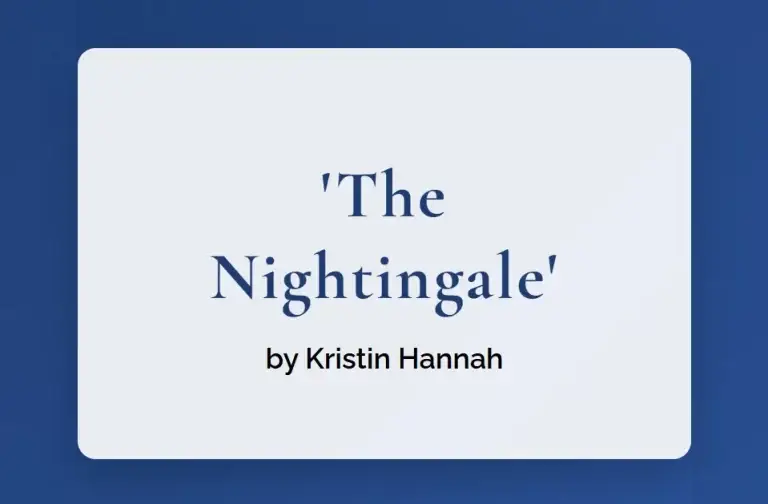The Nightingale by Kristin Hannah is a masterful exploration of female courage during World War II, examining the depths of human resilience through sisterhood and sacrifice.
Table of Contents
- Introduction
- The Symbol of the Nightingale
- Sisters in War: Contrasting Forms of Resistance
- The French Resistance Through a Female Lens
- Literary Techniques in The Nightingale
- Conclusion
Introduction
In “The Nightingale,” Kristin Hannah masterfully reimagines the female experience of World War II through the compelling narrative of two sisters in Nazi-occupied France. This haunting tale of courage, resistance, and survival challenges traditional war narratives by illuminating the often-overlooked heroism of women who fought their own battles on the home front and in the resistance movement.
The Symbol of the Nightingale
The nightingale serves as both a literal and metaphorical symbol throughout the novel, representing the power of voice in the face of oppression. Just as the nightingale’s song pierces through darkness, Isabelle Rossignol (whose surname meaning “nightingale” proves significant) becomes “The Nightingale,” a resistance fighter who guides downed Allied airmen across the Pyrenees to safety:
“In love we find out who we want to be; in war we find out who we are.”
This central metaphor extends beyond Isabelle to encompass all women who refused to remain silent during the occupation, their acts of resistance—both grand and subtle—echoing like birdsong through history.
Sisters in War: Contrasting Forms of Resistance
Hannah presents two distinct paths of resistance through sisters Vianne and Isabelle, challenging readers to reconsider their understanding of heroism:
Vianne’s Quiet Resistance
- Protection of Jewish children
- Survival through strategic compliance
- Maintenance of hope and humanity
- Silent defiance in daily acts
Isabelle’s Active Resistance
- The Nightingale escape network
- Direct confrontation with occupying forces
- Physical and emotional sacrifice
- Public acts of defiance
Through these parallel narratives, Hannah demonstrates that resistance takes many forms, each requiring its own kind of courage.
The French Resistance Through a Female Lens
The novel’s exploration of the French Resistance movement through female perspectives offers a fresh examination of this historical period. Hannah writes:
“Men tell stories. Women get on with it. For us it was a shadow war. There were no parades for us when it was over, no medals or mentions in history books. We did what we had to during the war, and when it was over, we picked up the pieces and started our lives over.”
This poignant observation underscores the novel’s central theme: the unsung heroism of women during wartime. The author weaves historical accuracy with emotional depth, creating a narrative that both educates and moves readers.
Literary Techniques in The Nightingale
Similar to the narrative complexity found in The Sound and the Fury or Crime and Punishment, Hannah employs several sophisticated literary techniques to enhance the novel’s impact:
- Dual Timeline Structure
- Modern-day framework (1995)
- Historical narrative (1939-1945)
- Creates tension and mystery around the sisters’ fate
- Symbolism
- The nightingale (resistance and voice)
- The list (documentation and memory)
- The carved bird (heritage and survival)
- Perspective Shifts
- Multiple viewpoints revealing different wartime experiences
- Intimate access to characters’ internal struggles
- Broader historical context through personal lenses
Historical Context and Contemporary Relevance
Before reaching our conclusion, it’s crucial to examine how “The Nightingale” fits within the broader context of war literature and female narratives. Like Literature and Politics: 7 Influential Texts, Hannah’s novel demonstrates how personal stories illuminate larger historical truths. The author’s meticulous research into the French Resistance, combined with her imaginative exploration of women’s wartime experiences, creates a narrative that both documents history and transcends it.
The novel’s examination of moral choices under occupation draws parallels with other significant works exploring human nature under extreme circumstances, such as Heart of Darkness. However, Hannah’s focus on female characters provides a fresh perspective on the moral ambiguities of survival and resistance.
Impact on Contemporary Literature
“The Nightingale” has influenced how contemporary authors approach historical fiction, particularly in its treatment of:
- Female agency in historical narratives
- The complexity of moral choices during wartime
- The intergenerational impact of trauma
- The role of memory in shaping historical understanding
This approach to historical fiction has paved the way for other authors to explore similar themes, contributing to a broader understanding of women’s roles in historical events.
Conclusion
“The Nightingale” transcends the boundaries of historical fiction to become a profound meditation on courage, sisterhood, and the multifaceted nature of resistance. Through her masterful storytelling, Hannah ensures that the often-forgotten stories of women’s wartime resistance receive the recognition they deserve.
Related Posts:
- The God of Small Things by Arundhati Roy – Another powerful exploration of sisterhood and resistance
- Fire on the Mountain by Anita Desai – Examining female relationships in times of crisis
- The Island of Missing Trees by Elif Shafak – War’s impact on family bonds
Share your thoughts: How does Hannah’s portrayal of female resistance during World War II challenge or enhance your understanding of this historical period? Join the discussion in the comments below.


